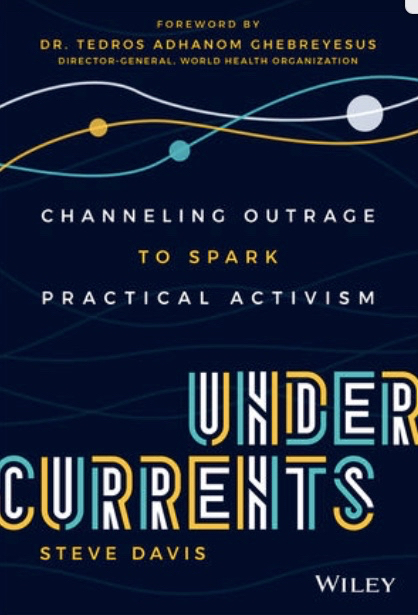By Lucy White, December 18, 2020
Undercurrents: Channeling Outrage to Spark Practical Activism, Steve Davis, Wiley, October 6, 2020, 208 pp., $32.03
If you’re reading this review, at some point you have likely wanted to change the world or at least leave it a better place than you found it. So let’s cut to the chase: buy this book.
Steve Davis has a bold and timely proposition for his readers: We can channel our outrage about persistent systemic inequities and injustices into practical activism to improve the world we live in. In Undercurrents: Channeling Outrage to Spark Practical Activism, Davis lays out a process for doing just that.
The word undercurrents refers to deep and mighty tides invisible to a person navigating on the surface of an ocean. Undercurrents do not always flow in the same direction as the waves on top of the water; indeed, sometimes these underwater channels can pull us backward. But often, they surge forward, propelling the way water drifts, or landscapes form, or social change moves.
Davis points to five macrotrends or “undercurrents” that he believes will shape the work of practical activism in future and which could be harnessed to drive social change:
- Pyramid to diamond: Vastly more people are joining the middle class. The movement of people from the bottom of the global economy to the middle is creating a fat diamond representing opportunities for significantly improved well-being.
- Communities are the customers: Communities are increasingly playing a role in shaping their own futures rather than being passive recipients of aid from outside.
- Leveling the playing field: Equity is improving on many fronts and radically reshaping social activism.
- Digital disruption: The rise of digital tools and data are revolutionizing all aspects of our lives and this presents both opportunities as well as challenges for activists.
- The surprisingly sexy middle: Activists who know how to effectively adapt and scale up their innovations will be making widespread impact and that’s sexy.
Undercurrents is a master class in systems change taught by someone who has been in the trenches and used that outrage to fuel a lifetime of activism. The core of the book are the chapters detailing each macrotrend with examples mostly drawn from Davis’ own experiences.
It begins with Davis’ visit in his early 20s to a post-Vietnam War refugee camp where he is surprised to realize that he and the teenaged boy with whom he plays soccer are not so very different.
He clearly considered himself my equal in a very unequal world. These thoughts swirled in my mind, upending my ideas around “us or them” and “survivors or victims,” as it became increasingly clear that the differences between us came down to little more than chance. There was nothing exceptional about me as an American, nothing more than privilege conferred by the luck of circumstance.
Undercurrents is peppered with anecdotes and stories that demonstrate how Davis took that insight and made it into a career. The stories are key to understanding Davis’ theories about practical activism and they enliven his slightly dry style of writing making this book very approachable. The chapter about The Surprisingly Sexy Middle, was of particular interest as so many great ideas die after being piloted. I wanted to understand how scaling up could be done successfully. Davis makes the point throughout Undercurrents that collaboration, partnerships, and compromise, are absolutely necessary for social change. In bringing a brilliant idea to scale, entrepreneurs must overcome the “twin valleys of death” – getting a product of service from the drawing board to launch pad and from launch to widespread uptake. This process almost always involves complex partnerships, compromise and other unglamorous tools.
To illustrate, Davis makes a riveting story about how a food-safety technology was adapted for use in international vaccination efforts. After working for 10 years to solve the problem of vaccines becoming ineffective on their long journey from manufacturer to child, a key partner was ready to pull the plug.
“This is where relationships come in,”Davis writes. The project leadership flew from Seattle to New Jersey to meet with their partner. The leaders described the enormous market and possibilities for impact on the lives of millions of children.
“I remember the meeting in the room when we said we were giving up,” their reluctant partner recalls 25 years later, “I still get choked up.” Without the strong partnerships that had been cultivated, the project would have ended on that day or, indeed, at any time in the next 20 years it took for the solution to be successfully implemented.
I enjoyed Undercurrents very much and I know I’ll go back to it again. If I have one criticism it is that the outrage promised in the title is missing from the narrative. You can certainly read outrage into the text as Davis describes some truly appalling situations and challenges but his writing is more professorial than rabble-rousing.
Davis is a self-professed problem-solver not rule-breaker whose activism is mostly behind-the-scenes so this isn’t much of a surprise however much I would have preferred a more passionate writing style.
Davis is an avowed optimist in a world that too often favours cynicism and “influencers” over substance and activism.
Davis ends Undercurrents with a series of stories about social activists and their projects where the macrotrends have converged, Davis points out that, despite all the lessons he has conveyed in this book, the most essential requirement of activism is showing up.
“You must put your shoulder to the wheel and do the work, not simply lob complaints from the sidelines.”
Despite frightening daily headlines, Davis says that the worldwide macrotrends demonstrate that we are making undeniable progress and that there is more to be done.
(Lucy White is currently a principal at The Osborne Group in Toronto.)
Also reviewed by Lucy White
Conversations with Buddha & Ingenious: Noble truths, now and next February 14, 2020
